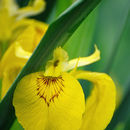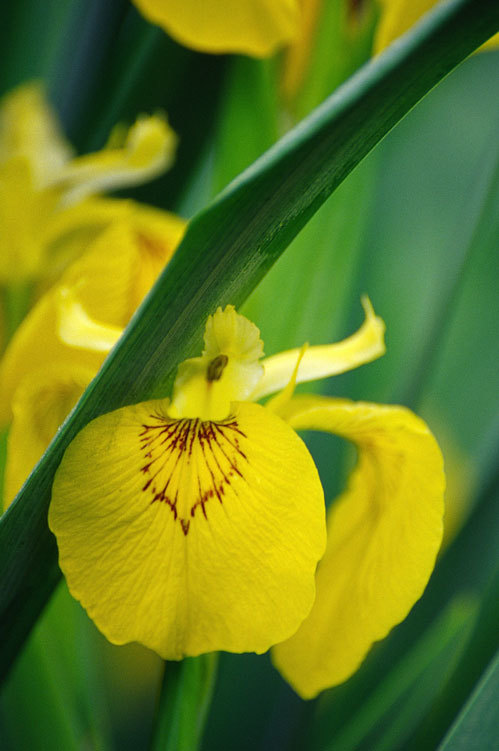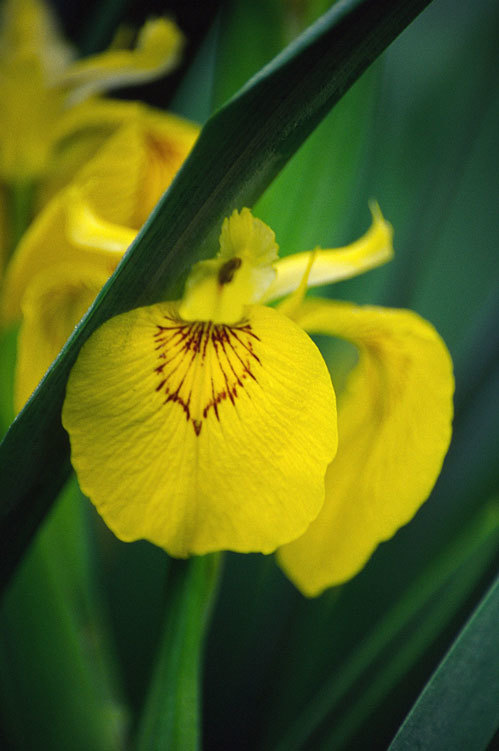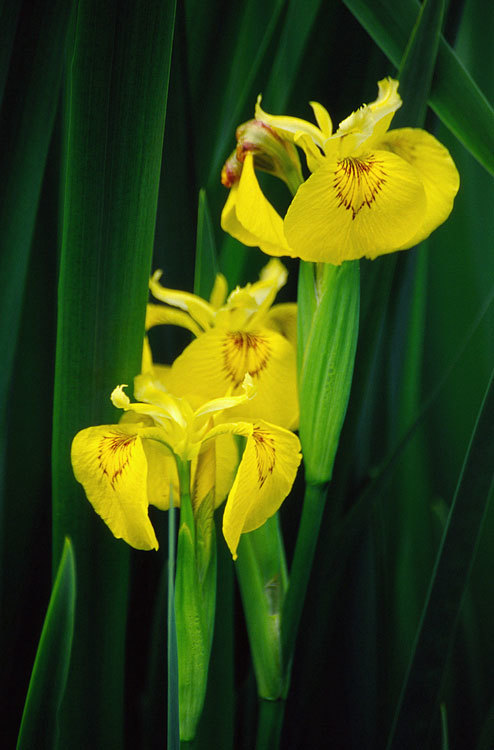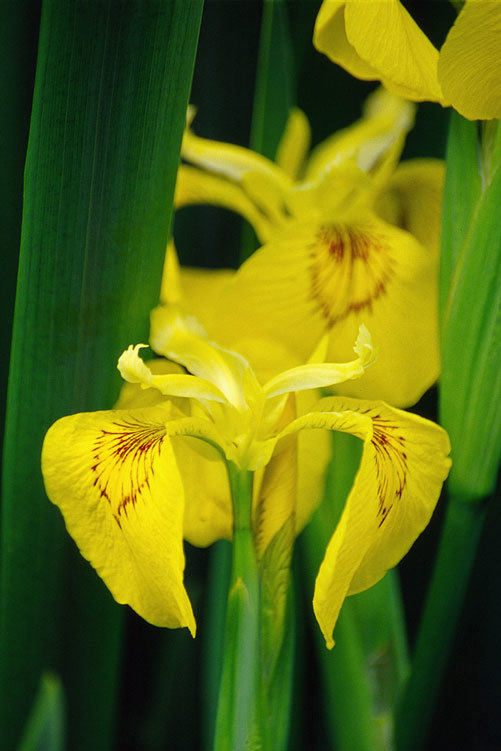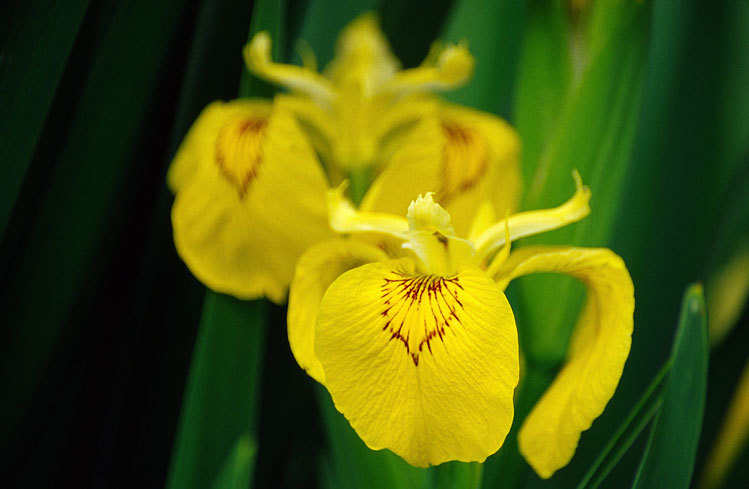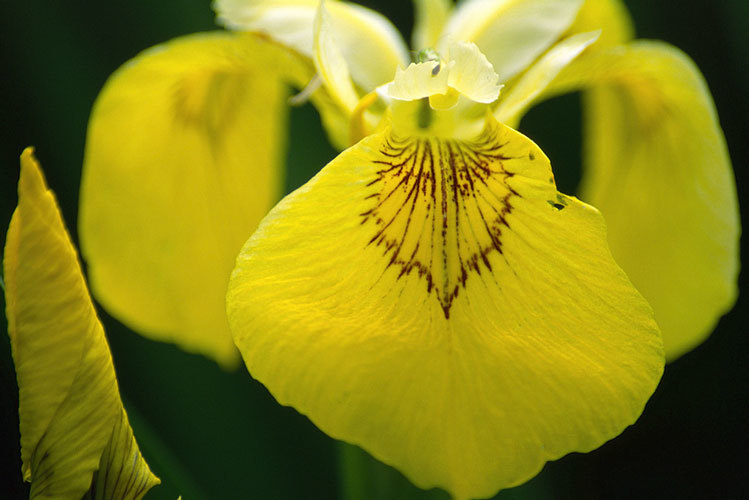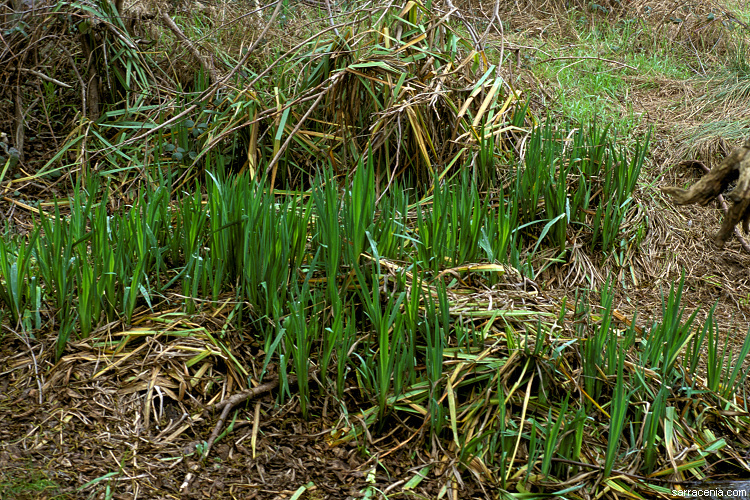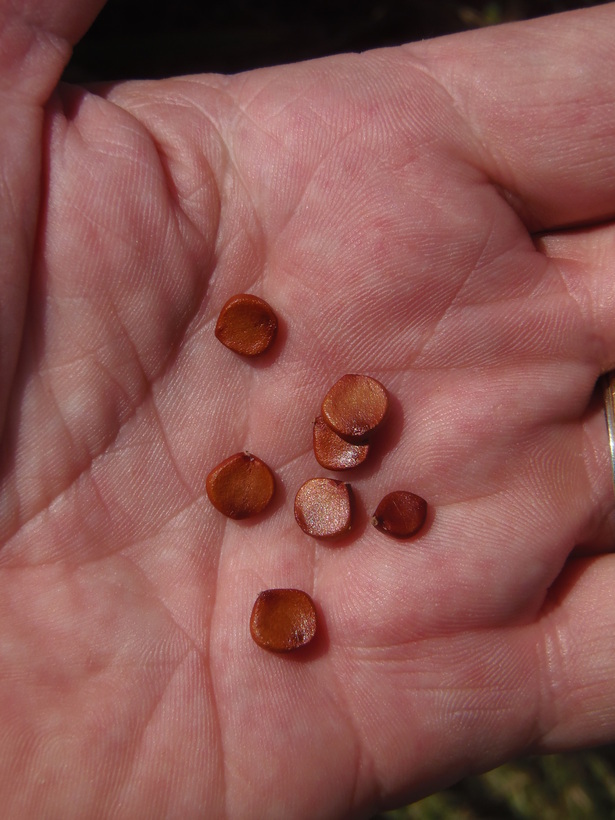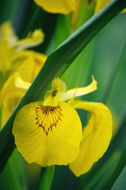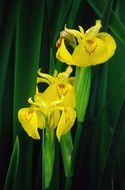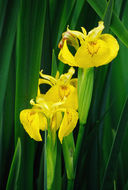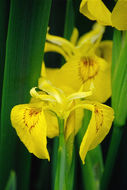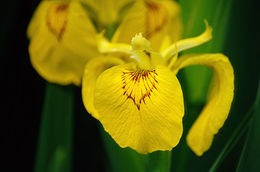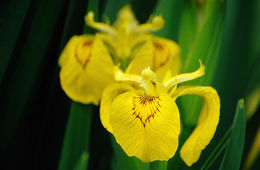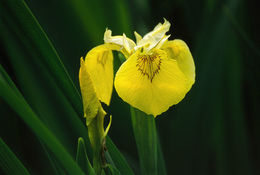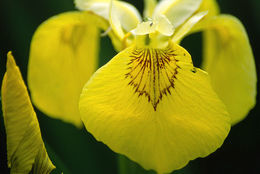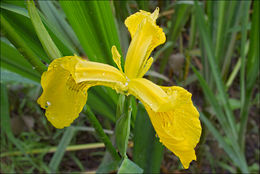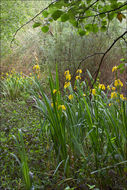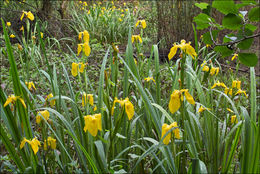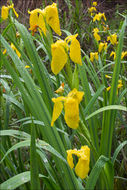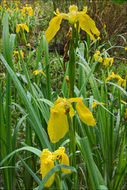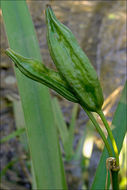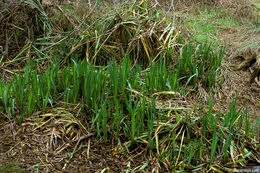-
-
-
-
-
-
-
-
-
-
-
-
-

Slo.: vodna perunika - Habitat: in a dense thicket of wet marsh; a long time ago abandoned, manmade, large size clay pit; now almost full of nearby stream deposits, thrown away construction material and other garbage; among tall herbs, shrubs and trees; mostly several Salix sp., Acer pseudoplatanus, Acer negundo, Fraxinus excelsior, Fraxinus ornus, Euonymus europaea, Cornus sanguinea, Corylus avellana, etc.; flat terrain, thick muddy ground, cretaceous clastic rock (flysh), humid place, usually flooded during rainy periods; mostly in shade, average precipitations ~ 3.000 mm/year, average temperature 8-10 deg C, elevation 450 m (1.500 feet), alpine phytogeographical region. - Substratum: clayey soil with lot of humus. - Comment: I found the leaves of this beautiful Iris in summer 2011, however I didn't recognize them convinced that Iris pseudacorus is quite rare and doesn't grow in this part of Slovenia. It can be found mainly on wet, low land places of east and central part of the country. The leaves resembles strongly to Iris genus, but were much too large for other options of wild species of this genus, which grow in Slovenia. I thought that the leaves had to belong to some garden plant, which escaped into wild. This was quite probable since the place was a kind of semiruderal terrain and not far from the nearest houses of town Bovec. Only later, after seeing fruits and flowers, we realized that it is indeed Iris pseudacorus. This find was the first and is, even today, the only known place where it grows wild in northwest Slovenia. - Protected according to 'Uredba o zavarovanih prostoiveih rastlinskih vrstah' Ur.l. RS, t.46/2004 ('Regulation of protected wild plants', Official Gazette RS, No.46/2004). Enlisted in the Slovene Red List of rare and endangered species, marked by 'V' representing a vulnerable species. - Ref.: (1) A. Martini et all., Mala Flora Slovenije, Tehnina Zaloba Slovenije (2007), p 752. (2) K. Lauber and G. Wagner, Flora Helvetica, 5. Auflage, Haupt (2012), p 1294. (3) M.A. Fischer, W. Adler, K. Oswald, Exkursionsflora Oesterreich, Liechtenstein und Suedtirol, LO Landesmuseen, Linz, Austria (2005), p 1026. (4) N. Jogan (ed.), Gradivo za Atlas flore Slovenije (Materials for the Atlas of Flora of Slovenia), CKSF (2001), p207.
-
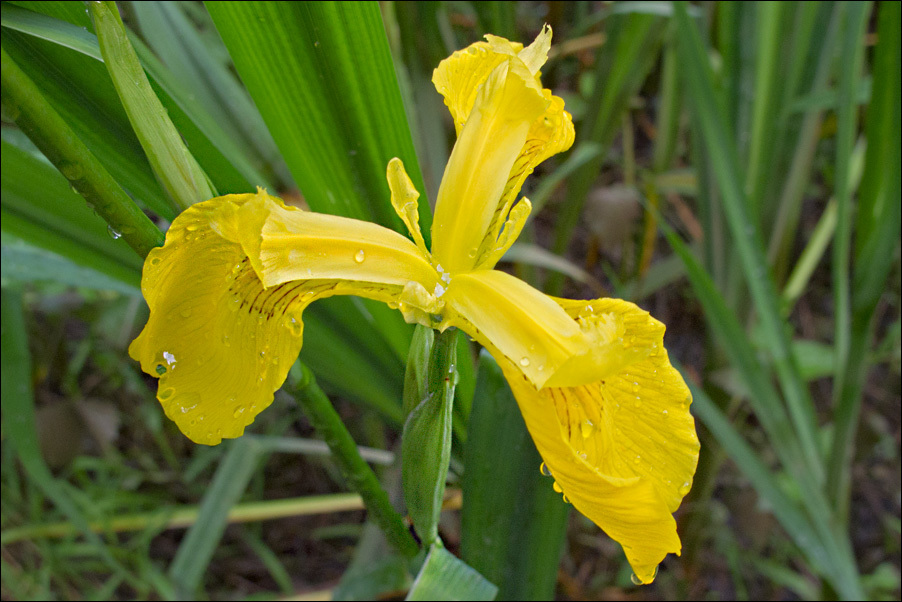
Slo.: vodna perunika - Habitat: in a dense thicket of wet marsh; a long time ago abandoned, manmade, large size clay pit; now almost full of nearby stream deposits, thrown away construction material and other garbage; among tall herbs, shrubs and trees; mostly several Salix sp., Acer pseudoplatanus, Acer negundo, Fraxinus excelsior, Fraxinus ornus, Euonymus europaea, Cornus sanguinea, Corylus avellana, etc.; flat terrain, thick muddy ground, cretaceous clastic rock (flysh), humid place, usually flooded during rainy periods; mostly in shade, average precipitations ~ 3.000 mm/year, average temperature 8-10 deg C, elevation 450 m (1.500 feet), alpine phytogeographical region. - Substratum: clayey soil with lot of humus. - Comment: I found the leaves of this beautiful Iris in summer 2011, however I didn't recognize them convinced that Iris pseudacorus is quite rare and doesn't grow in this part of Slovenia. It can be found mainly on wet, low land places of east and central part of the country. The leaves resembles strongly to Iris genus, but were much too large for other options of wild species of this genus, which grow in Slovenia. I thought that the leaves had to belong to some garden plant, which escaped into wild. This was quite probable since the place was a kind of semiruderal terrain and not far from the nearest houses of town Bovec. Only later, after seeing fruits and flowers, we realized that it is indeed Iris pseudacorus. This find was the first and is, even today, the only known place where it grows wild in northwest Slovenia. - Protected according to 'Uredba o zavarovanih prostoiveih rastlinskih vrstah' Ur.l. RS, t.46/2004 ('Regulation of protected wild plants', Official Gazette RS, No.46/2004). Enlisted in the Slovene Red List of rare and endangered species, marked by 'V' representing a vulnerable species. - Ref.: (1) A. Martini et all., Mala Flora Slovenije, Tehnina Zaloba Slovenije (2007), p 752. (2) K. Lauber and G. Wagner, Flora Helvetica, 5. Auflage, Haupt (2012), p 1294. (3) M.A. Fischer, W. Adler, K. Oswald, Exkursionsflora Oesterreich, Liechtenstein und Suedtirol, LO Landesmuseen, Linz, Austria (2005), p 1026. (4) N. Jogan (ed.), Gradivo za Atlas flore Slovenije (Materials for the Atlas of Flora of Slovenia), CKSF (2001), p207.
-

Slo.: vodna perunika - Habitat: in a dense thicket of wet marsh; a long time ago abandoned, manmade, large size clay pit; now almost full of nearby stream deposits, thrown away construction material and other garbage; among tall herbs, shrubs and trees; mostly several Salix sp., Acer pseudoplatanus, Acer negundo, Fraxinus excelsior, Fraxinus ornus, Euonymus europaea, Cornus sanguinea, Corylus avellana, etc.; flat terrain, thick muddy ground, cretaceous clastic rock (flysh), humid place, usually flooded during rainy periods; mostly in shade, average precipitations ~ 3.000 mm/year, average temperature 8-10 deg C, elevation 450 m (1.500 feet), alpine phytogeographical region. - Substratum: clayey soil with lot of humus. - Comment: I found the leaves of this beautiful Iris in summer 2011, however I didn't recognize them convinced that Iris pseudacorus is quite rare and doesn't grow in this part of Slovenia. It can be found mainly on wet, low land places of east and central part of the country. The leaves resembles strongly to Iris genus, but were much too large for other options of wild species of this genus, which grow in Slovenia. I thought that the leaves had to belong to some garden plant, which escaped into wild. This was quite probable since the place was a kind of semiruderal terrain and not far from the nearest houses of town Bovec. Only later, after seeing fruits and flowers, we realized that it is indeed Iris pseudacorus. This find was the first and is, even today, the only known place where it grows wild in northwest Slovenia. - Protected according to 'Uredba o zavarovanih prostoiveih rastlinskih vrstah' Ur.l. RS, t.46/2004 ('Regulation of protected wild plants', Official Gazette RS, No.46/2004). Enlisted in the Slovene Red List of rare and endangered species, marked by 'V' representing a vulnerable species. - Ref.: (1) A. Martini et all., Mala Flora Slovenije, Tehnina Zaloba Slovenije (2007), p 752. (2) K. Lauber and G. Wagner, Flora Helvetica, 5. Auflage, Haupt (2012), p 1294. (3) M.A. Fischer, W. Adler, K. Oswald, Exkursionsflora Oesterreich, Liechtenstein und Suedtirol, LO Landesmuseen, Linz, Austria (2005), p 1026. (4) N. Jogan (ed.), Gradivo za Atlas flore Slovenije (Materials for the Atlas of Flora of Slovenia), CKSF (2001), p207.
-
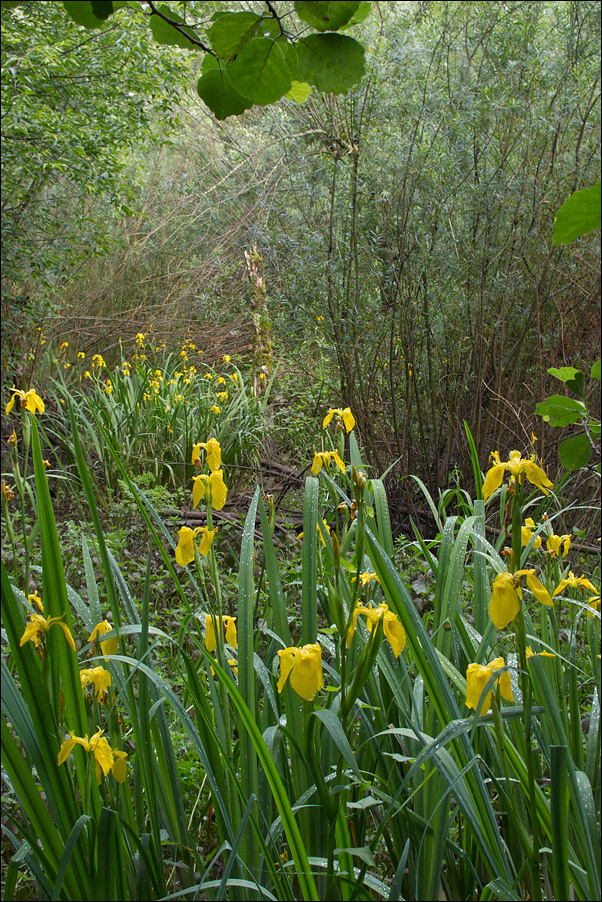
Slo.: vodna perunika - Habitat: in a dense thicket of wet marsh; a long time ago abandoned, manmade, large size clay pit; now almost full of nearby stream deposits, thrown away construction material and other garbage; among tall herbs, shrubs and trees; mostly several Salix sp., Acer pseudoplatanus, Acer negundo, Fraxinus excelsior, Fraxinus ornus, Euonymus europaea, Cornus sanguinea, Corylus avellana, etc.; flat terrain, thick muddy ground, cretaceous clastic rock (flysh), humid place, usually flooded during rainy periods; mostly in shade, average precipitations ~ 3.000 mm/year, average temperature 8-10 deg C, elevation 450 m (1.500 feet), alpine phytogeographical region. - Substratum: clayey soil with lot of humus. - Comment: I found the leaves of this beautiful Iris in summer 2011, however I didn't recognize them convinced that Iris pseudacorus is quite rare and doesn't grow in this part of Slovenia. It can be found mainly on wet, low land places of east and central part of the country. The leaves resembles strongly to Iris genus, but were much too large for other options of wild species of this genus, which grow in Slovenia. I thought that the leaves had to belong to some garden plant, which escaped into wild. This was quite probable since the place was a kind of semiruderal terrain and not far from the nearest houses of town Bovec. Only later, after seeing fruits and flowers, we realized that it is indeed Iris pseudacorus. This find was the first and is, even today, the only known place where it grows wild in northwest Slovenia. - Protected according to 'Uredba o zavarovanih prostoiveih rastlinskih vrstah' Ur.l. RS, t.46/2004 ('Regulation of protected wild plants', Official Gazette RS, No.46/2004). Enlisted in the Slovene Red List of rare and endangered species, marked by 'V' representing a vulnerable species. - Ref.: (1) A. Martini et all., Mala Flora Slovenije, Tehnina Zaloba Slovenije (2007), p 752. (2) K. Lauber and G. Wagner, Flora Helvetica, 5. Auflage, Haupt (2012), p 1294. (3) M.A. Fischer, W. Adler, K. Oswald, Exkursionsflora Oesterreich, Liechtenstein und Suedtirol, LO Landesmuseen, Linz, Austria (2005), p 1026. (4) N. Jogan (ed.), Gradivo za Atlas flore Slovenije (Materials for the Atlas of Flora of Slovenia), CKSF (2001), p207.
-

Slo.: vodna perunika - Habitat: in a dense thicket of wet marsh; a long time ago abandoned, manmade, large size clay pit; now almost full of nearby stream deposits, thrown away construction material and other garbage; among tall herbs, shrubs and trees; mostly several Salix sp., Acer pseudoplatanus, Acer negundo, Fraxinus excelsior, Fraxinus ornus, Euonymus europaea, Cornus sanguinea, Corylus avellana, etc.; flat terrain, thick muddy ground, cretaceous clastic rock (flysh), humid place, usually flooded during rainy periods; mostly in shade, average precipitations ~ 3.000 mm/year, average temperature 8-10 deg C, elevation 450 m (1.500 feet), alpine phytogeographical region. - Substratum: clayey soil with lot of humus. - Comment: I found the leaves of this beautiful Iris in summer 2011, however I didn't recognize them convinced that Iris pseudacorus is quite rare and doesn't grow in this part of Slovenia. It can be found mainly on wet, low land places of east and central part of the country. The leaves resembles strongly to Iris genus, but were much too large for other options of wild species of this genus, which grow in Slovenia. I thought that the leaves had to belong to some garden plant, which escaped into wild. This was quite probable since the place was a kind of semiruderal terrain and not far from the nearest houses of town Bovec. Only later, after seeing fruits and flowers, we realized that it is indeed Iris pseudacorus. This find was the first and is, even today, the only known place where it grows wild in northwest Slovenia. - Protected according to 'Uredba o zavarovanih prostoiveih rastlinskih vrstah' Ur.l. RS, t.46/2004 ('Regulation of protected wild plants', Official Gazette RS, No.46/2004). Enlisted in the Slovene Red List of rare and endangered species, marked by 'V' representing a vulnerable species. - Ref.: (1) A. Martini et all., Mala Flora Slovenije, Tehnina Zaloba Slovenije (2007), p 752. (2) K. Lauber and G. Wagner, Flora Helvetica, 5. Auflage, Haupt (2012), p 1294. (3) M.A. Fischer, W. Adler, K. Oswald, Exkursionsflora Oesterreich, Liechtenstein und Suedtirol, LO Landesmuseen, Linz, Austria (2005), p 1026. (4) N. Jogan (ed.), Gradivo za Atlas flore Slovenije (Materials for the Atlas of Flora of Slovenia), CKSF (2001), p207.
-
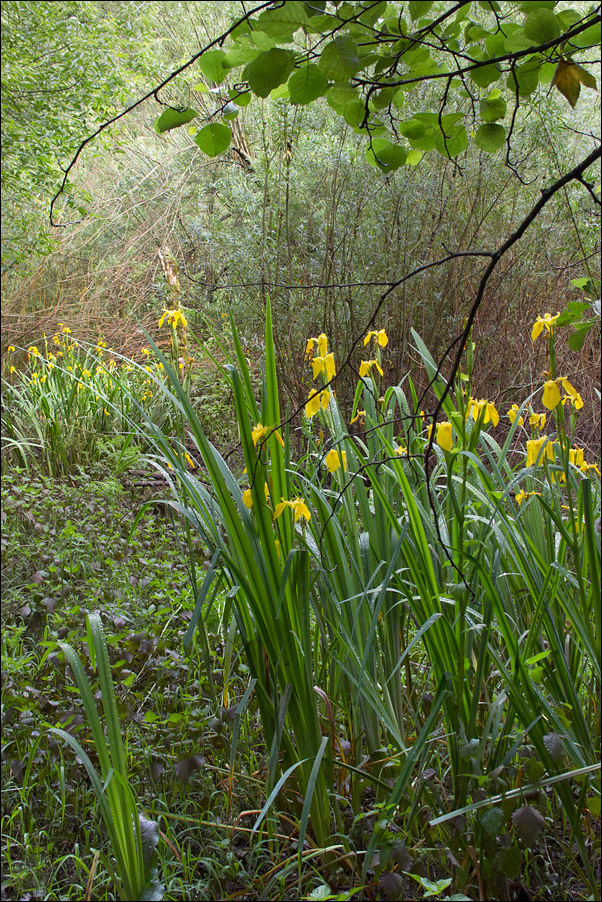
Slo.: vodna perunika - Habitat: in a dense thicket of wet marsh; a long time ago abandoned, manmade, large size clay pit; now almost full of nearby stream deposits, thrown away construction material and other garbage; among tall herbs, shrubs and trees; mostly several Salix sp., Acer pseudoplatanus, Acer negundo, Fraxinus excelsior, Fraxinus ornus, Euonymus europaea, Cornus sanguinea, Corylus avellana, etc.; flat terrain, thick muddy ground, cretaceous clastic rock (flysh), humid place, usually flooded during rainy periods; mostly in shade, average precipitations ~ 3.000 mm/year, average temperature 8-10 deg C, elevation 450 m (1.500 feet), alpine phytogeographical region. - Substratum: clayey soil with lot of humus. - Comment: I found the leaves of this beautiful Iris in summer 2011, however I didn't recognize them convinced that Iris pseudacorus is quite rare and doesn't grow in this part of Slovenia. It can be found mainly on wet, low land places of east and central part of the country. The leaves resembles strongly to Iris genus, but were much too large for other options of wild species of this genus, which grow in Slovenia. I thought that the leaves had to belong to some garden plant, which escaped into wild. This was quite probable since the place was a kind of semiruderal terrain and not far from the nearest houses of town Bovec. Only later, after seeing fruits and flowers, we realized that it is indeed Iris pseudacorus. This find was the first and is, even today, the only known place where it grows wild in northwest Slovenia. - Protected according to 'Uredba o zavarovanih prostoiveih rastlinskih vrstah' Ur.l. RS, t.46/2004 ('Regulation of protected wild plants', Official Gazette RS, No.46/2004). Enlisted in the Slovene Red List of rare and endangered species, marked by 'V' representing a vulnerable species. - Ref.: (1) A. Martini et all., Mala Flora Slovenije, Tehnina Zaloba Slovenije (2007), p 752. (2) K. Lauber and G. Wagner, Flora Helvetica, 5. Auflage, Haupt (2012), p 1294. (3) M.A. Fischer, W. Adler, K. Oswald, Exkursionsflora Oesterreich, Liechtenstein und Suedtirol, LO Landesmuseen, Linz, Austria (2005), p 1026. (4) N. Jogan (ed.), Gradivo za Atlas flore Slovenije (Materials for the Atlas of Flora of Slovenia), CKSF (2001), p207.
-

Slo.: vodna perunika - Habitat: in a dense thicket of wet marsh; a long time ago abandoned, manmade, large size clay pit; now almost full of nearby stream deposits, thrown away construction material and other garbage; among tall herbs, shrubs and trees; mostly several Salix sp., Acer pseudoplatanus, Acer negundo, Fraxinus excelsior, Fraxinus ornus, Euonymus europaea, Cornus sanguinea, Corylus avellana, etc.; flat terrain, thick muddy ground, cretaceous clastic rock (flysh), humid place, usually flooded during rainy periods; mostly in shade, average precipitations ~ 3.000 mm/year, average temperature 8-10 deg C, elevation 450 m (1.500 feet), alpine phytogeographical region. - Substratum: clayey soil with lot of humus. - Comment: I found the leaves of this beautiful Iris in summer 2011, however I didn't recognize them convinced that Iris pseudacorus is quite rare and doesn't grow in this part of Slovenia. It can be found mainly on wet, low land places of east and central part of the country. The leaves resembles strongly to Iris genus, but were much too large for other options of wild species of this genus, which grow in Slovenia. I thought that the leaves had to belong to some garden plant, which escaped into wild. This was quite probable since the place was a kind of semiruderal terrain and not far from the nearest houses of town Bovec. Only later, after seeing fruits and flowers, we realized that it is indeed Iris pseudacorus. This find was the first and is, even today, the only known place where it grows wild in northwest Slovenia. - Protected according to 'Uredba o zavarovanih prostoiveih rastlinskih vrstah' Ur.l. RS, t.46/2004 ('Regulation of protected wild plants', Official Gazette RS, No.46/2004). Enlisted in the Slovene Red List of rare and endangered species, marked by 'V' representing a vulnerable species. - Ref.: (1) A. Martini et all., Mala Flora Slovenije, Tehnina Zaloba Slovenije (2007), p 752. (2) K. Lauber and G. Wagner, Flora Helvetica, 5. Auflage, Haupt (2012), p 1294. (3) M.A. Fischer, W. Adler, K. Oswald, Exkursionsflora Oesterreich, Liechtenstein und Suedtirol, LO Landesmuseen, Linz, Austria (2005), p 1026. (4) N. Jogan (ed.), Gradivo za Atlas flore Slovenije (Materials for the Atlas of Flora of Slovenia), CKSF (2001), p207.
-
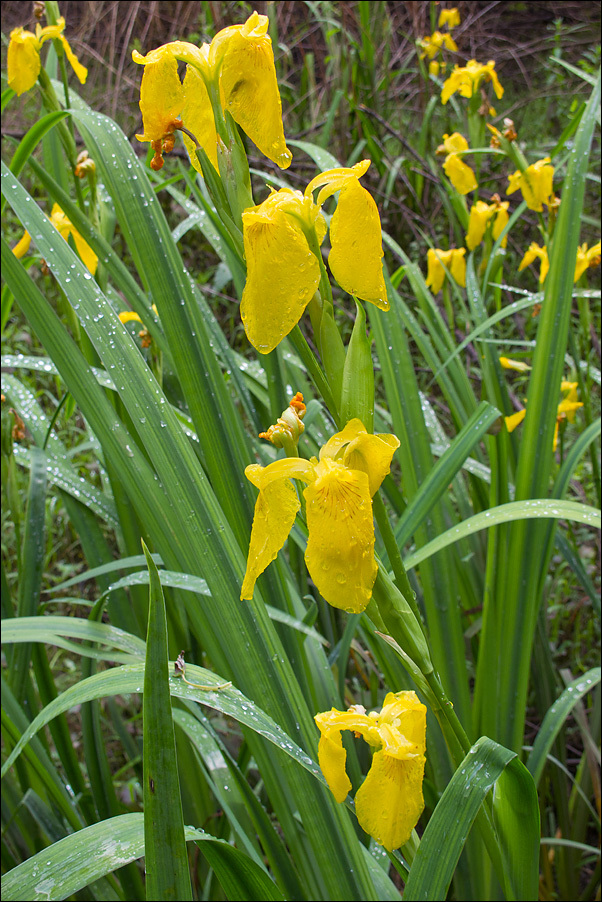
Slo.: vodna perunika - Habitat: in a dense thicket of wet marsh; a long time ago abandoned, manmade, large size clay pit; now almost full of nearby stream deposits, thrown away construction material and other garbage; among tall herbs, shrubs and trees; mostly several Salix sp., Acer pseudoplatanus, Acer negundo, Fraxinus excelsior, Fraxinus ornus, Euonymus europaea, Cornus sanguinea, Corylus avellana, etc.; flat terrain, thick muddy ground, cretaceous clastic rock (flysh), humid place, usually flooded during rainy periods; mostly in shade, average precipitations ~ 3.000 mm/year, average temperature 8-10 deg C, elevation 450 m (1.500 feet), alpine phytogeographical region. - Substratum: clayey soil with lot of humus. - Comment: I found the leaves of this beautiful Iris in summer 2011, however I didn't recognize them convinced that Iris pseudacorus is quite rare and doesn't grow in this part of Slovenia. It can be found mainly on wet, low land places of east and central part of the country. The leaves resembles strongly to Iris genus, but were much too large for other options of wild species of this genus, which grow in Slovenia. I thought that the leaves had to belong to some garden plant, which escaped into wild. This was quite probable since the place was a kind of semiruderal terrain and not far from the nearest houses of town Bovec. Only later, after seeing fruits and flowers, we realized that it is indeed Iris pseudacorus. This find was the first and is, even today, the only known place where it grows wild in northwest Slovenia. - Protected according to 'Uredba o zavarovanih prostoiveih rastlinskih vrstah' Ur.l. RS, t.46/2004 ('Regulation of protected wild plants', Official Gazette RS, No.46/2004). Enlisted in the Slovene Red List of rare and endangered species, marked by 'V' representing a vulnerable species. - Ref.: (1) A. Martini et all., Mala Flora Slovenije, Tehnina Zaloba Slovenije (2007), p 752. (2) K. Lauber and G. Wagner, Flora Helvetica, 5. Auflage, Haupt (2012), p 1294. (3) M.A. Fischer, W. Adler, K. Oswald, Exkursionsflora Oesterreich, Liechtenstein und Suedtirol, LO Landesmuseen, Linz, Austria (2005), p 1026. (4) N. Jogan (ed.), Gradivo za Atlas flore Slovenije (Materials for the Atlas of Flora of Slovenia), CKSF (2001), p207.
-

Slo.: vodna perunika - Habitat: in a dense thicket of wet marsh; a long time ago abandoned, manmade, large size clay pit; now almost full of nearby stream deposits, thrown away construction material and other garbage; among tall herbs, shrubs and trees; mostly several Salix sp., Acer pseudoplatanus, Acer negundo, Fraxinus excelsior, Fraxinus ornus, Euonymus europaea, Cornus sanguinea, Corylus avellana, etc.; flat terrain, thick muddy ground, cretaceous clastic rock (flysh), humid place, usually flooded during rainy periods; mostly in shade, average precipitations ~ 3.000 mm/year, average temperature 8-10 deg C, elevation 450 m (1.500 feet), alpine phytogeographical region. - Substratum: clayey soil with lot of humus. - Comment: I found the leaves of this beautiful Iris in summer 2011, however I didn't recognize them convinced that Iris pseudacorus is quite rare and doesn't grow in this part of Slovenia. It can be found mainly on wet, low land places of east and central part of the country. The leaves resembles strongly to Iris genus, but were much too large for other options of wild species of this genus, which grow in Slovenia. I thought that the leaves had to belong to some garden plant, which escaped into wild. This was quite probable since the place was a kind of semiruderal terrain and not far from the nearest houses of town Bovec. Only later, after seeing fruits and flowers, we realized that it is indeed Iris pseudacorus. This find was the first and is, even today, the only known place where it grows wild in northwest Slovenia. - Protected according to 'Uredba o zavarovanih prostoiveih rastlinskih vrstah' Ur.l. RS, t.46/2004 ('Regulation of protected wild plants', Official Gazette RS, No.46/2004). Enlisted in the Slovene Red List of rare and endangered species, marked by 'V' representing a vulnerable species. - Ref.: (1) A. Martini et all., Mala Flora Slovenije, Tehnina Zaloba Slovenije (2007), p 752. (2) K. Lauber and G. Wagner, Flora Helvetica, 5. Auflage, Haupt (2012), p 1294. (3) M.A. Fischer, W. Adler, K. Oswald, Exkursionsflora Oesterreich, Liechtenstein und Suedtirol, LO Landesmuseen, Linz, Austria (2005), p 1026. (4) N. Jogan (ed.), Gradivo za Atlas flore Slovenije (Materials for the Atlas of Flora of Slovenia), CKSF (2001), p207.
-
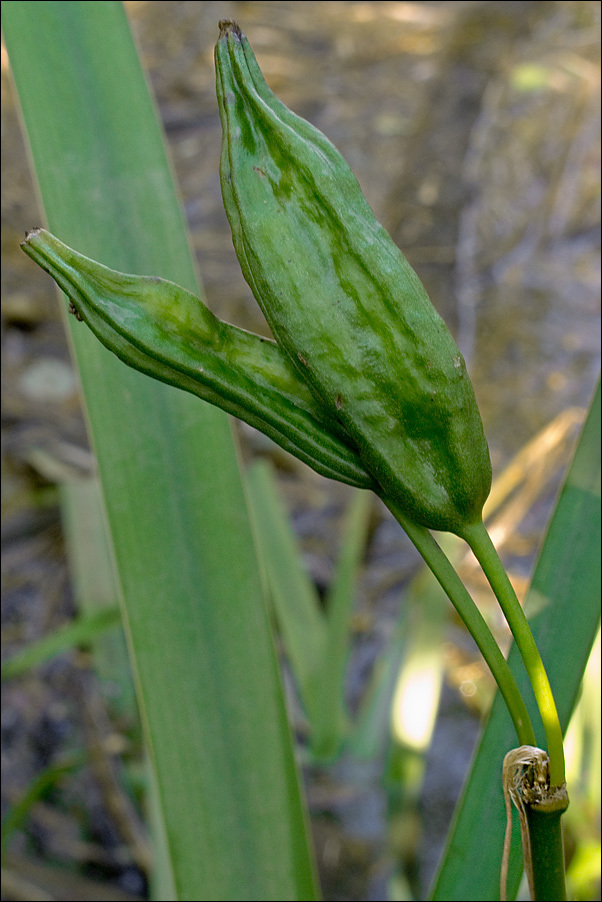
Slo.: vodna perunika - Habitat: in a dense thicket of wet marsh; a long time ago abandoned, manmade, large size clay pit; now almost full of nearby stream deposits, thrown away construction material and other garbage; among tall herbs, shrubs and trees; mostly several Salix sp., Acer pseudoplatanus, Acer negundo, Fraxinus excelsior, Fraxinus ornus, Euonymus europaea, Cornus sanguinea, Corylus avellana, etc.; flat terrain, thick muddy ground, cretaceous clastic rock (flysh), humid place, usually flooded during rainy periods; mostly in shade, average precipitations ~ 3.000 mm/year, average temperature 8-10 deg C, elevation 450 m (1.500 feet), alpine phytogeographical region. - Substratum: clayey soil with lot of humus. - Comment: I found the leaves of this beautiful Iris in summer 2011, however I didn't recognize them convinced that Iris pseudacorus is quite rare and doesn't grow in this part of Slovenia. It can be found mainly on wet, low land places of east and central part of the country. The leaves resembles strongly to Iris genus, but were much too large for other options of wild species of this genus, which grow in Slovenia. I thought that the leaves had to belong to some garden plant, which escaped into wild. This was quite probable since the place was a kind of semiruderal terrain and not far from the nearest houses of town Bovec. Only later, after seeing fruits and flowers, we realized that it is indeed Iris pseudacorus. This find was the first and is, even today, the only known place where it grows wild in northwest Slovenia. - Protected according to 'Uredba o zavarovanih prostoiveih rastlinskih vrstah' Ur.l. RS, t.46/2004 ('Regulation of protected wild plants', Official Gazette RS, No.46/2004). Enlisted in the Slovene Red List of rare and endangered species, marked by 'V' representing a vulnerable species. - Ref.: (1) A. Martini et all., Mala Flora Slovenije, Tehnina Zaloba Slovenije (2007), p 752. (2) K. Lauber and G. Wagner, Flora Helvetica, 5. Auflage, Haupt (2012), p 1294. (3) M.A. Fischer, W. Adler, K. Oswald, Exkursionsflora Oesterreich, Liechtenstein und Suedtirol, LO Landesmuseen, Linz, Austria (2005), p 1026. (4) N. Jogan (ed.), Gradivo za Atlas flore Slovenije (Materials for the Atlas of Flora of Slovenia), CKSF (2001), p207.
-
-

